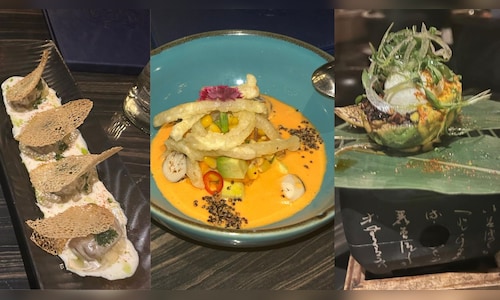“My roots lie in Peruvian culture, while Japanese culture has transformed into a philosophy I’ve embraced since my culinary career began. Nikkei cuisine acts as a bridge where both cultures coexist, and I find myself at the center, honoring and reinterpreting them in every dish,” shares Chef Lan Thorne, Chef de Cuisine at Koishii.
Nikkei cuisine is a fusion stemming from the convergence of traditional Japanese techniques and Peruvian ingredients. “Key components include fresh fish, a variety of chili peppers—yellow, limo, rocoto, and panca—quinoa, alongside Japanese staples like soy, miso, and dashi. This blend empowers us to craft dishes rooted in Japanese techniques yet brimming with the vibrant flavors of Peru,” he adds.
Koishii operates under the philosophy of “contemporary Nikkei,” which reinterpret this cuisine using local Indian ingredients while incorporating elements from Japan and Peru.
“For instance, we directly import chili peppers from Peru to preserve the authentic flavor, but we also blend in local spices and fresh produce to enhance our offerings. It’s about striking a balance—honoring the essence of Nikkei while integrating influences from our local environment, making Koishii truly distinctive,” explains Chef Thorne.

Recently, Koishii has launched new menu items such as Ahiru Gyoza, Truffle Quinoa Gyoza, Mango Ceviche, Tropical Salmon, Smoked Rocoto Ceviche, Shishito Tempura, Gunkan Furai, Softshell Crab Maki Rolls, Avocado Brasa, Shromi Amazonico, Peruvian BBQ Chilean Sea Bass, Panco Miso Black Cod Yakitori, Tallarin Saltado Criollo, and Parma Tiradito, with notable dessert additions like Suspiro A La Limena and Rocotto Chocolate Fondant.
With a blend of Peruvian ingredients, Japanese techniques, and Indian spices, Koishii has redefined classic Nikkei cuisine, fostering a cultural dialogue among three diverse backgrounds.

Chef Thorne reveals that crafting the menu was a months-long process of refinement. The primary challenge was to preserve the core of Nikkei cuisine while tailoring it to suit Indian palates, which have rich and intricate culinary traditions. “A balance was essential—for instance, I reduced acidity in some dishes, moderated spiciness in others, and emphasized umami and sweetness. Fresh, local produce played a role as well, considering seasonality, and I explored traditional Indian ingredients,” he reflects.
A prime example of this fusion is the Nikkei Ceviche, featuring nuances of yuzu ponzu, tamarind, and tiger’s milk. “The Indian tamarind introduces a distinctive acidity and sweetness that harmonizes beautifully with the Japanese ponzu and classic Peruvian tiger’s milk,” he notes.

Chef Thorne believes we are at a pivotal moment for contemporary Nikkei, which must carry on evolving to innovate while remaining true to its roots and narrating stories through each dish. “That’s my daily goal at Koishii and in every endeavor I undertake—to honor the past, engage with the present, and pave the way for the future of Nikkei cuisine,” he asserts.
The term tiger’s milk, or Leche de tigre, refers to the lime marinade used in making ceviche.

When Chef Thorne began his culinary journey two decades ago, Nikkei cuisine was still relatively unknown outside of Peru. While sushi and some traditional Peruvian dishes were recognized, the fusion of these cultures was not widely embraced, he recalls. The flavors were more straightforward and classic—ceviche, tiradito, sushi with Peruvian influences—seeking to establish its identity in the culinary sphere.
“Now, Nikkei cuisine has progressed to a contemporary and global perspective. It has transcended mere fusion to become a unique language. New cooking techniques, fermentation, and fish aging are now commonplace, with influences from cuisines like Amazonian and Mediterranean. Contemporary Nikkei no longer exclusively highlights Japan and Peru, but rather embraces local ingredients from various countries while retaining its core essence,” he explains.
Also Read: This Mumbai restaurant expands its Italian roots with wider Mediterranean flavours



